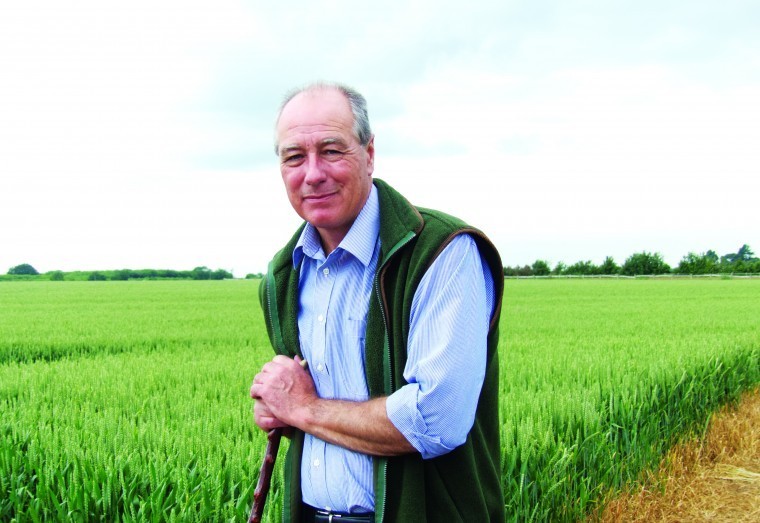At the practical level it keeps on raining with another five inches since the last article but with some abatement in that November has only seen about three inches but of course that means October got to seven inches. The one saving grace is that it has been mild with everything growing well and one would have to say crops in general are in good condition.
The problems have been finishing drilling and managing spraying. As mentioned last month the very wet weather created problems with delayed pre emergence herbicide applications on wheat crops and the result is more blackgrass than one would choose to see. On one field we simply gave up without committing the cost of the residual, sprayed off with glyphosphate, re drilled and got a pre emergence residual on at the second attempt.
All the wheat has a residual applied and we are attempting to top up with second residuals as best we can in the face of challenging conditions. Aphids are a concern with the mild weather and applications of insecticide on second wheats which did not have Deter seed dressing are a priority. No doubt first wheats where we used Deter will join the list if or when we make progress. With so little spraying time, the spraying to do list does seem to be getting rather long.
Oilseed rape has simply transformed into fields of massive plants. Even very late emerging seeds have grown to make decent plants and there are very few bare patches left in any fields now. Centurion Max has worked well on rye grass and blackgrass where we have used it. The follow up of Kerb really does need to wait for some frost to lower ground temperatures and to knock the oilseed rape leaves over and expose some soil to get the residual chemical onto the ground. There are signs of phoma but not as much one might expect in the circumstances and perhaps it is being hidden by the huge vegetative growth we are seeing. Treatment will just have to fit in with Kerb application.
Finally to our winter beans. About two thirds have been drilled using a Moore tine drill to get sufficient depth of soil cover with the intention of delaying herbicide application as long as possible using a contact to clear up any emerged weeds and a combination of pre emergence broad leaved and grass weed residuals. Warm soils have meant we only just got into November and the herbicides had to be applied before the beans emerged which really was too early for Kerb. But again there is nothing one can do about the weather and missing pre emergence applications on beans is disastrous. We do still have acreage to drill but if the opportunity does not come between now and Christmas we will simply change to spring beans in due course.
On a positive note, prices have been recovering from late harvest lows despite the pessimism in the trade. While they are still at disappointing levels it is a more positive place to be with physical exports of wheat picking up to start moving the exportable surplus. I mentioned last month that I was increasingly pessimistic about national output of arable crops and focussed on the obvious contributing effects of blackgrass control and the basic payment scheme (BPS) greening requirements highlighting the three crop rule. There are of course other competing land uses which further erode potential food production.
I will leave development pressures for another day but the renewable sector is having a significant impact on cereal production. Where we started with biodiesel and bioethanol was fine as it affected the demand side of the equation and any use of wheat and oilseed that soaked up production tonnage sooner or later was going to tighten supply and apply upwards price pressure in the market locally or globally.
Then we had wind and photovoltaics (PV) which are of variable efficiency in the UK but are useful business diversifications for many farms. Both are detrimental to landscape views and PV farms can occupy land that could be used for food production but is probably peaking with current permitted schemes.
Then we come to anaerobic digesters (AD) which are more efficient but certainly do take significant land out of food production and into growing predominantly maize. This is fundamentally skewing the cost base of arable production by putting a rent floor in farm business tenancy rents for a significant area around every AD plant.
When wheat was near £200 a tonne, that did not seem to matter but at the much lower current market prices it is a significant factor and attempting rent reviews with an AD plant within haulage distance is a difficult task. It is also the practice that delivered the reason for the three crop rule in the first place, with large areas of monoculture maize in Germany driving the European Commission’s regulatory ambition and affecting everyone who intends to claim under the new BPS.
It has always been the one form of renewable energy that has concerned me from a policy point of view and it certainly is a difficult call for our lobbying organisations. They cannot be all things to all farmers. Sooner or later they will have to come to a decision to lobby government for a change in focus if they are serious about maintaining food production in the UK let alone increasing it. If it is difficult for our representative bodies to come to a view then it really is a challenge for government and politicians.




